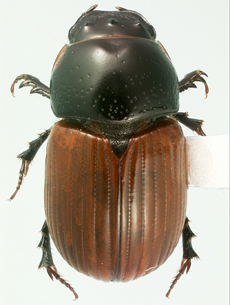 |
|||||||
|
|||||||
Aphodius Illiger, 1798
Aphodius Illiger, 1798: 15
Photo by P. Skelley.
|
||
|
||
| Aphodiinae Overview | ||
| Aphodiini Key |
Type species. Scarabaeus fimetarius Linnaeus 1758: 348, by subsequent designation.
= Platycephalus Cuvier 1798: 517, [not Platycephalus Block 1795, Pisces]. Type species: Scarabaeus fimetarius Linnaeus 1758: 348.
= Rhodaphodius Adam 1994: 5. Type species: Scarabaeus foetens Fabricus 1787.
= Cytoderhinus Seabra 1909: 15. Type species: Scarabaeus fimetarius Linnaeus 1758.
Diagnosis. Body length 6.5-9.5 mm, elongate, robust; black with solid red elytra. Head with distinct tubercles, more prominent in males. Pronotum of male with distinct anterior-median depression. Metatibial apical spinules short, equal in length.
Distribution. Palearctic; North America south to Mexico.
Composition. Worldwide, Aphodius contains 12 species, only one introduced species is recognized in the New World.
Aphodius fimetarius (Linnaeus 1758: 348) [Scarabaeus], Europe, N. America and Mexico (introduced).
= Scarabaeus bicolor Geoffroy 1785: 9.
= Aphodius fimetivorus Gistel 1857: 588.
= Aphodius nodifrons Randall 1838: 20.
= Scarabaeus pedellus Degeer 1774: 266.
= Scarabaeus autumnalis Naezen 1792: 167.
= Aphodius orophilus Charpentrier 1825: 210.
= Aphodius bicolorellus Schmidt 1922: 273.
= Aphodius bilcoloratus Schmidt 1916: 96.
= Aphodius bicolor Mulsant 1842: 187.
= Aphodius castaneus Bouskell 1901: 16.
= Aphodius hypopygialis Mulsant 1842: 187.
= Aphodius imperfectus Mulsant 1842: 187.
= Aphodius maculipennis Mulsant 1842: 187.
= Aphodius punctulatus Mulsant 1842: 187.
= Aphodius subluteus Mulsant 1842: 187.
= Aphodius. cardinalis Reitter 1892: 186.
= Aphodius monticola Heer 1841: 513.
Life History. A surface generalist, apparently preferring moist bovine dung.
Larvae. The larvae of A. fimetarius has been described several times, the most recent by Ritcher (1966).
Status of Classification. Aphodius fimetarius was recently studied using karyotype data, which revealed two genetically different species (Wilson 2001). These karyotypes were attributed to A. fimetarius and A. pedellus. Morphologically, these species are difficult to separate, showing much character overlap. Subsequent papers have maintained them as synonyms pending further study (Gordon and Skelley 2007).
References:
Dellacasa, M. and G. Dellacasa. 2003. Review of the genus Aphodius. Folia Heyrovskyana 11(3-4): 173-202.
Gordon, R. D., and P. E. Skelley. 2007. A monograph of the Aphodiini inhabiting the United States and Canada (Coleoptera: Scarabaeidae: Aphodiinae). Memoirs of the American Entomological Institute 79: 580 pp.
Ritcher, P.O. 1966. White grubs and their allies: A study of North American scarabaeoid larvae. Oregon State University Press, Corvallis, Oregon. Studies in Entomology 4: 219 pp.
Wilson, C. J. 2001. Aphodius pedellus (Degeer), a species distinct from A. fimetarius (Linnaeus) (Coleoptera: Aphodiidae). Tijdschridft voor Entomologie 144: 137-143.
|
||||
| Author:Paul Skelley Generated on: 28/APR/08.....Last modified: 28/APR/08 University of Nebraska State Museum - Division of Entomology |
